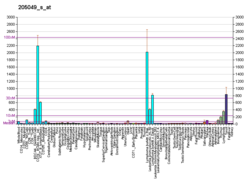Top Qs
Timeline
Chat
Perspective
CD79A
Protein-coding gene in humans From Wikipedia, the free encyclopedia
Remove ads
Cluster of differentiation CD79A also known as B-cell antigen receptor complex-associated protein alpha chain and MB-1 membrane glycoprotein, is a protein that in humans is encoded by the CD79A gene.[5]
The CD79a protein together with the related CD79b protein, forms a dimer associated with membrane-bound immunoglobulin in B-cells, thus forming the B-cell antigen receptor (BCR). This occurs in a similar manner to the association of CD3 with the T-cell receptor, and enables the cell to respond to the presence of antigens on its surface.[6]
It is associated with agammaglobulinemia-3.[7]
Remove ads
Gene
The mouse CD79A gene, then called mb-1, was cloned in the late 1980s,[8] followed by the discovery of human CD79A in the early 1990s.[9][10] It is a short gene, 4.3 kb in length, with 5 exons encoding for 2 splice variants resulting in 2 isoforms.[5]
CD79A is conserved and abundant among ray-finned fish (actinopterygii) but not in the evolutionarily more ancient chondrichthyes such as shark.[11] The occurrence of CD79A thus coincides with the evolution of B cell receptors with greater diversity generated by recombination of multiple V, D, and J elements in bony fish contrasting the single V, D and J elements found in shark.[12]
Remove ads
Structure
CD79a is a membrane protein with an extracellular immunoglobulin domain, a single span transmembrane region and a short cytoplasmic domain.[5] The cytoplasmic domain contains multiple phosphorylation sites including a conserved dual phosphotyrosine binding motif, termed immunotyrosine-based activation motif (ITAM).[13][14] The larger CD79a isoform contains an insert in position 88-127 of human CD79a resulting in a complete immunoglobulin domain, whereas the smaller isoform has only a truncated Ig-like domain.[5] CD79a has several cysteine residues, one of which forms covalent bonds with CD79b.[15]
Remove ads
Function
Summarize
Perspective
CD79a plays multiple and diverse roles in B cell development and function. The CD79a/b heterodimer associates non-covalently with the immunoglobulin heavy chain through its transmembrane region, thus forming the BCR along with the immunoglobulin light chain and the pre-BCR when associated with the surrogate light chain in developing B cells. Association of the CD79a/b heterodimer with the immunoglobulin heavy chain is required for surface expression of the BCR and BCR induced calcium flux and protein tyrosine phosphorylation.[16] Genetic deletion of the transmembrane exon of CD79A results in loss of CD79a protein and a complete block of B cell development at the pro to pre B cell transition.[17] Similarly, humans with homozygous splice variants in CD79A predicted to result in loss of the transmembrane region and a truncated or absent protein display agammaglobulinemia and no peripheral B cells.[7][18][19]
The CD79a ITAM tyrosines (human CD79a Tyr188 and Tyr199, mouse CD79a Tyr182 and Tyr193) phosphorylated in response to BCR crosslinking are critical for binding of Src-homology 2 domain-containing kinases such as spleen tyrosine kinase (Syk) and signal transduction by CD79a.[20][21] In vivo, the CD79a ITAM tyrosines synergize with the CD79b ITAM tyrosines to mediate the transition from the pro to the pre B cell stage as suggested by the analysis of mice with targeted mutations of the CD79a and CD79b ITAM.[22][23] Loss of only one of the two functional CD79a/b ITAMs resulted in impaired B cell development but B cell functions such as the T cell independent type II response and BCR mediated calcium flux in the available B cells were intact. However, the presence of both the CD79a and CD79b ITAM tyrosines were required for normal T cell dependent antibody responses.[22][24] The CD79a cytoplasmic domain further contains a non-ITAM tyrosine distal to the CD79a ITAM (human CD79a Tyr210, mouse CD79a Tyr204) that can bind BLNK and Nck once phosphorylated,[25][26][27] and is critical for BCR mediated B cell proliferation and B1 cell development.[28] CD79a ITAM tyrosine phosphorylation and signaling is negatively regulated by serine and threonine residues in direct proximity of the ITAM (human CD79a Ser197, Ser203, Thr209; mouse CD79a Ser191, Ser197, Thr203),[29][30] and play a role in limiting formation of bone marrow plasma cells secreting IgG2a and IgG2b.[23]
Remove ads
Diagnostic relevance
The CD79a protein is present on the surface of B-cells throughout their life cycle, and is absent on all other healthy cells, making it a highly reliable marker for B-cells in immunohistochemistry. The protein remains present when B-cells transform into active plasma cells, and is also present in virtually all B-cell neoplasms, including B-cell lymphomas, plasmacytomas, and myelomas. It is also present in abnormal lymphocytes associated with some cases of Hodgkins disease. Because even on B-cell precursors, it can be used to stain a wider range of cells than can the alternative B-cell marker CD20, but the latter is more commonly retained on mature B-cell lymphomas, so that the two are often used together in immunohistochemistry panels.[6]
Remove ads
See also
References
Further reading
External links
Wikiwand - on
Seamless Wikipedia browsing. On steroids.
Remove ads





